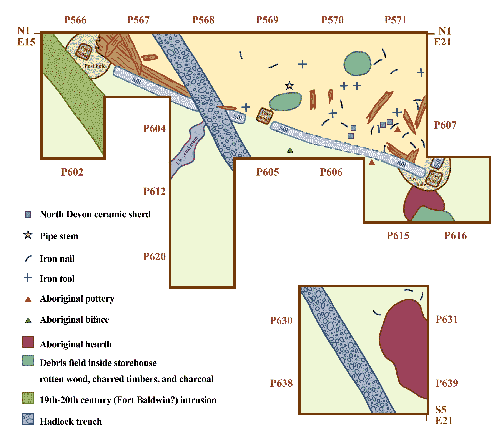|
.
The Eastern Abenaki are comprised of several closely related Algonquian-speaking
tribes in the northeastern United States who archaeologically may be traced
to both late prehistoric and contact periods. By the time of European arrival
in the northeast in the 16th and 17th centuries AD, indigenous people as
the Abenaki and their predecessors had lived along Maine’s coast for
millennia.
Subsistence:
Primarily hunter-gatherers, the Abenaki also practiced limited horticulture,
and cultivated maize by about AD 1000 (with the Kennebec River marking the
northernmost soil and climatic conditions suitable for maize growing). They
lived along the coast in larger groups during the warm months and dispersed
inland as smaller family units during the winter, utilizing at specific seasons
many different wild food resources including fish, shellfish, porpoises,
seals, moose, deer, beaver, rabbit, woodchuck, wild fruits, and tubers.
Domesticated dogs helped the Abenaki track game. Stone tools, shell beads,
and shell-tempered and cord-marked pottery are well known archaeological
finds of their manufactures (fig.1).
 Contact with Europeans: Brief and possibly tense encounters took place
between the Abenaki and
Verrazzano’s crew
in southern Maine in 1524. Sporadic interaction with European fishermen and
explorers in the 16th century and with colonists in the 17th century led
to native use of some European goods, including durable metal tools, colored
glass beads, and alcohol. As demand for beaver skins and hats increased in
Europe, skyrocketing prices for beaver pelts spurred more European venturers
to bargain with New England’s indigenous hunters. Contact with Europeans: Brief and possibly tense encounters took place
between the Abenaki and
Verrazzano’s crew
in southern Maine in 1524. Sporadic interaction with European fishermen and
explorers in the 16th century and with colonists in the 17th century led
to native use of some European goods, including durable metal tools, colored
glass beads, and alcohol. As demand for beaver skins and hats increased in
Europe, skyrocketing prices for beaver pelts spurred more European venturers
to bargain with New England’s indigenous hunters.
Fig.1: Excavations at the south end of the storehouse at Maine's
Popham Colony (built in 1607-1608) reveal probable Eastern Abenaki artifacts
and occupational features including hearths (Brain 1999). While the fur trade
was profitable for some Native Americans, it also tended to create intertribal
competitions lasting through the 17th century, which in some ways paralleled
those between rival European trading companies. Coastal tribes such as the
Penobscott of the Eastern Abenaki had a strategic advantage in reaching the
European traders first, and were able to establish themselves in the profitable
role of middlemen between the Europeans and inland tribes. Increasing friction
between upland and coastal tribes helped spark the Tarrantine War (1607-1615),
when Micmacs raided the East Abenakis. This invasion, in combination
with a devastating epidemic, resulted in the Indians of this region abandoning
horticultural practices.
Popham Colony seems to
have been virtually set in the middle of this conflict. By the time of
Popham’s founding in 1607, the Eastern Abenaki had already made substantial
contact with some Europeans as evidenced by some of them knowing French.
Yet they often showed unwillingness to trade with the new English arrivals.
For the colonists, a profitable trade network thus failed to flourish. For
the Native Americans, meanwhile, profits became less reciprocal, and severe
outbreaks of new diseases coincided with increasing colonist contact.
References:
Brain, Jeffrey P. 1999. Fort St. George IV: 1999 Excavations
at the Site of the 1607-1608 Popham Colony on the Kennebec River in
Maine. Peabody Essex Museum, Salem, MA.
Brain, Jeffrey P. 2001.
The Popham Colony, An Historical and Archaeological Brief.
3d. Rev. Peabody Essex Museum, Salem, MA.
Brasser, T. J. 1978. “Early
Indian-European Contacts” in W. Sturtevant (ed.) Handbook of North
American Indians, Vol.15. Smithsonian Inst., Washington DC.
Snow, Dean
R. 1978. “Eastern Abenaki” and “Late Prehistory of the East
Coast” in W. Sturtevant (ed.). Handbook of North
American Indians, Vol.15. Smithsonian Inst., Washington DC.
This article appears on p.88 in Vol.3, No.2 of Athena
Review.
.
|
|